Top 15 Interesting Facts about Archimedes
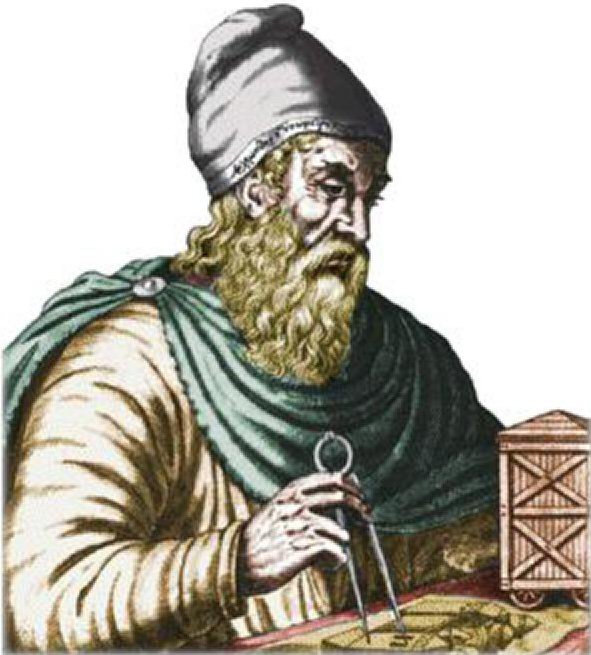
Archimedes was born around 287 BCE in the town of Syracuse in Sicily and he
lived there until his death around 212 BCE. Archimedes is famous for his
contribution to the world of mathematics, specifically geometry, and is regarded
as one of the greatest mathematicians who ever lived. He was the first person to
create the equations for determining the area as well as volume of spheres,
found the measurement formula of circles along with cones, discovered the actual
value of PI and led the way to integral calculus. Archimedes was also a great
scientist and inventor, contributing to the world of physics. Because he lived
so long ago and many writings both by him and about him have been lost, there is
not much information known about Archimedes' actual life. However, there are
many legends that persist about Archimedes that have lasted through the ages,
like: his significant mathematical advances and his scientific
discoveries. This all contributes to some known truths about Archimedes,
like these fifteen facts.
15) Invented the
Water Screw
|
Archimedes Screw
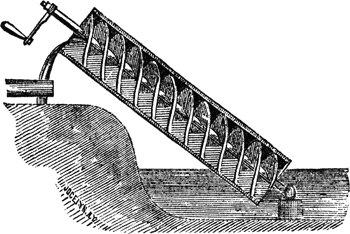
|
One of the important inventions of Archimedes was the water screw, which is
still used for irrigation in Egypt and developing countries today. King Hieron
II wanted Archimedes to design a magnificent ship for multi use, including:
luxury travel, naval warfare and carrying supplies. According to Greek writer
Athenaeus of Naucratis, this ship was the largest ship built in antiquity and it
was basically an ancient version of a cruise ship that could also partake in
battle. The ship could apparently carry 600 people, had garden decorations, a
gymnasium and a temple to Aphrodite. The one downside to such a large ship was
that it would leak water, which caused all sorts of problems but Archimedes came
up with a solution by creating the water screw. This machine had hollow tubes
with a spiral that could be turned by a handle at one end and when you placed
the lower end of the tube into the hull of the ship and turned the handle, the
water was carried up the tube. The same design could raise water out of the
ground in order to bring it to fields, making it perfect for irrigation.
14) Made War
Machines
Archimedes may be known as a father of mathematics today but in his own
lifetime, he was celebrated for his building of war machines. One of the most
famous machines was the "Claw of Archimedes", also known as the ship shaker.It
worked through a crane like arm with a large metal grappling hook that would
drop onto the attacking ship, according to legend. Then the arm would
swing upwards, lifting the ship out of the water and sinking it. He built the
crane when his hometown Syracuse was under siege by the Romans and it helped
hold them off for three years. He also invented rock throwing catapults and
grappling hooks to aid in the defense of Syracuse. There has been some doubt as
to whether the "Claw of Archimedes" actually worked however, an experiment
performed for a 2005 TV documentary concluded it could.
Claw of Archimedes
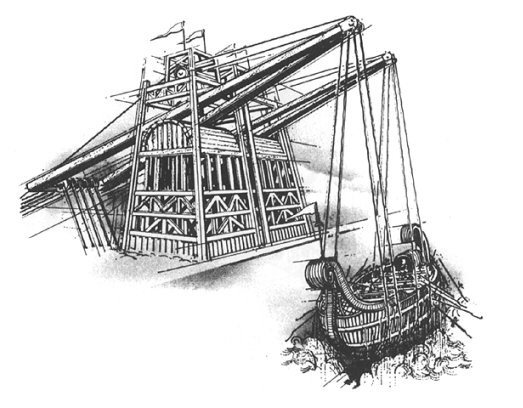
13) Made a Heat Ray
Another famous but debatable war machine built by Archimedes was a heat ray. In
the second century CE, writer Lucian said Archimedes destroyed ships with fire.
Anthemius of Tralles also discussed these devices, describing them as burning
glasses or the Archimedes heat ray. Basically, Archimedes developed a device to
use mirrors to reflect the sun to make the passing ships catch fire. There has
been debate since the Renaissance about the credibility of the stories of
Archimedes' heat ray and the efficiency as well as the reality of it. Some
scientists have been able to validate its possibilities, while others have shown
that it was not possible. Bronze or copper shields may have been used as the
mirrors, applying the principle of parabolic reflector.
In 1973, Greek scientist Ioannis Sakkas tested out the validity of the heat
ray at the Skaramages naval base outside Athens. He used seventy mirrors with
copper coating that were about 5 feet by 3 feet and the mirrors were pointed at
a plywood mockup of a Roman warship that was about 160 feet away. The mockup of
the ship had a coating of tar paint, which was commonplace during Archimedes'
lifetime and would aid in the combustion. When focused accurately, the ship went
up in flames in minutes. Students at MIT in 2005 also tested the accuracy of the
heat ray using 127 one foot square mirror tiles. They found that it took ten
minutes for flames to occur and only with a cloudless sky and stationary ship.
Although it could be feasible, it would be impractical because it would need
such precise conditions. The MIT students took their experiment on the show Myth
Busters, which concluded the myth was "busted". However, they did say that the
mirrors could still have been used to blind, dazzle or distract the crew.
12) Created a
Miniature Planetarium
Archimedes was not only interested in math and engineering, he also had an
interest in astronomy. He supposedly created a miniature planetarium that
imitated the motion of the earth, moon, sun and five planets known in his
lifetime. According to legend, there were two such planetariums that went back
to Rome with General Marcellus after Archimedes' death. Cicero wrote in his
dialogue "De re publica" that Marcellus kept one and donated the other to the
Temple of Virtue in Rome. Pappus of Alexandria also wrote about Archimedes'
planetariums, saying Archimedes had written a manuscript on the construction of
a planetarium. The knowledge of Archimedes' planetarium is entirely based upon
writings after his lifetime, so it is not certain he did make it. For a long
time scientists did not believe Archimedes could've been able to create such a
device due to a lack of knowledge of differential gearing but the discovery of
an Antikythera mechanism in 1902 demonstrated that the ancient Greeks had
knowledge about these types of devices, so it is entirely possible that
Archimedes built one.
Antikythera mechanism discovered in 1902
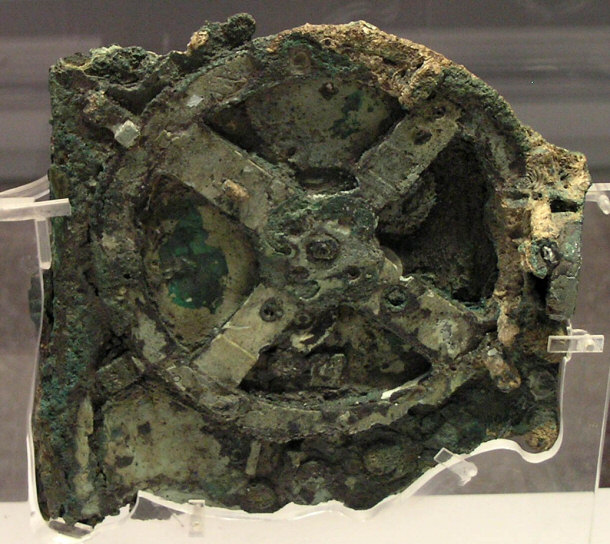
By unknown, via
Wikimedia Commons
Replica of an Antikythera Model
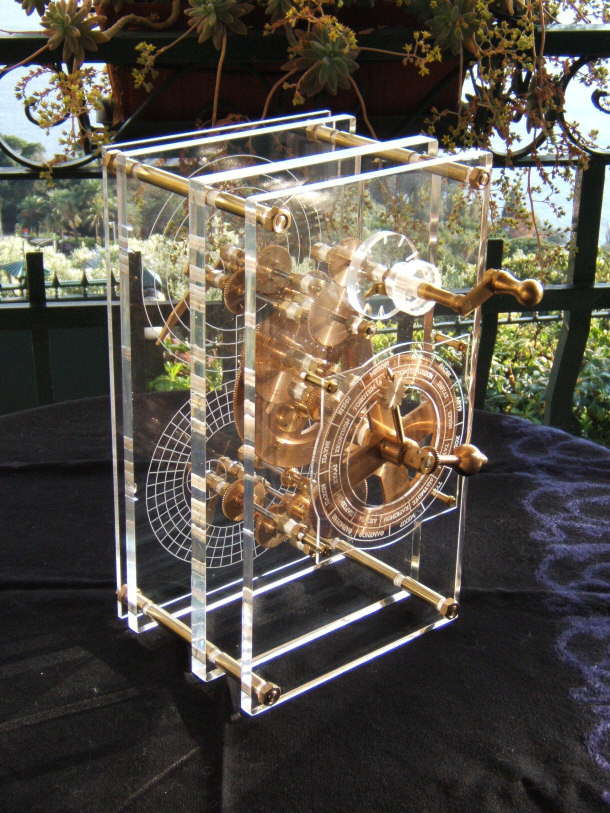
By
Mogi, via
Wikimedia Commons
11) Invented the
Phrase "Eureka"
One of the most famous stories about Archimedes involves one of his famous
principles and his most famous quote. According to legend, king Hieron came to
Archimedes when he suspected a crown maker had used some silver in a crown that
was supposed to be pure gold. Archimedes was troubled for a while but One day
when Archimedes took a bath, he realized that there was a direct correlation to
the water overflowing from the tub with his immersed body. He allegedly ran
through the streets naked yelling, "Eureka" after discovering this. This phrase
has become commonplace when finally discovering the answer, since Archimedes.
Whether or not he actually discovered this while in the bath, he did create a
principle of hydrostatics described in "On Floating Bodies". The principle
states that a body immersed in a fluid is buoyed up by a force equal to the
weight of the fluid displaced by the body. With this principle, Archimedes could
help the king. He could decide how much gold was actually in the crown by
comparing the weights of silver and gold in the water and compare that data with
the crown. Using this principle, Archimedes could prove the crown was not pure
gold and the crown maker had in fact tried to cheat the King.
The Eureka moment
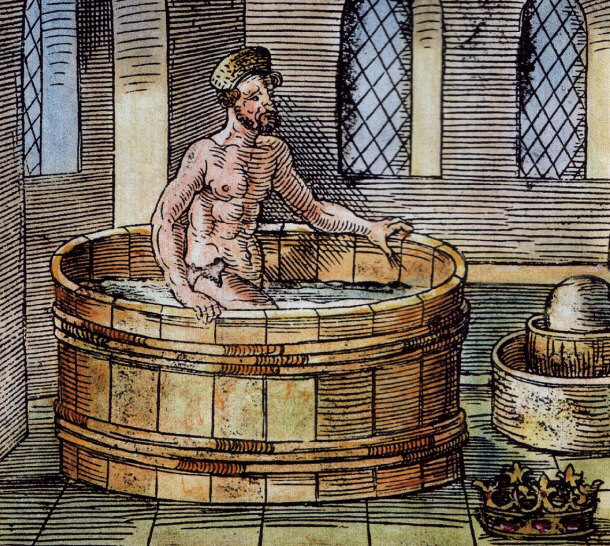
10) Worked with
Pulleys and Levers
Archimedes often worked and studied pulleys along with levers. According to
Plutarch, Archimedes designed block and tackle pulley systems so that a sailor
would be able to use leverage in order to lift heavy objects. Papus of
Alexandria says that Archimedes' work on levers made him say, "Give me a place
to stand on, and I will move the earth". A famous legend about Archimedes and
his work with levers is that he once moved a fully loaded ship by himself, while
seated from very far away. Whether he ever actually moved a ship or not, he
definitely understood how to use pulleys and levers to aid in lifting heavy
objects. He demonstrated this knowledge through his creation of the Claw of
Archimedes, which was basically a large crane.
Archimedes and his lever
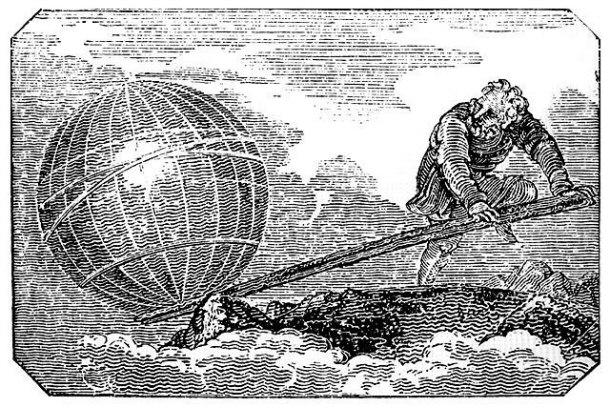
Pulley
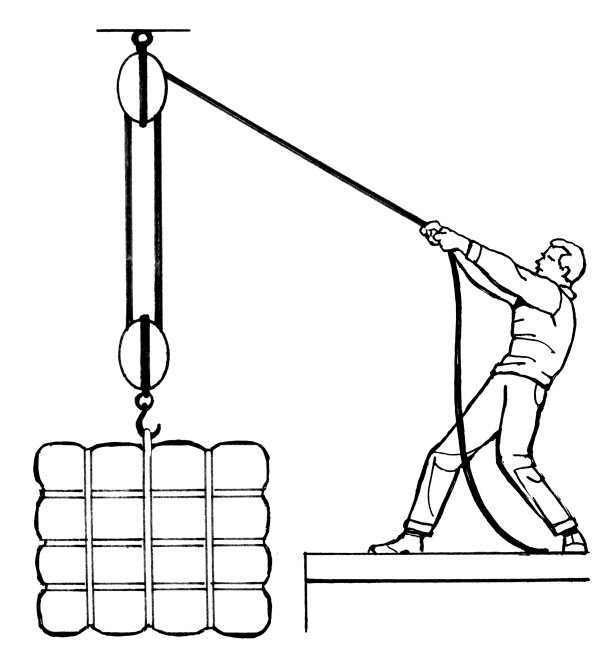
9) Rome Wanted Him
Alive
Archimedes was well known for his powers of invention and by the time Rome
succeeded in sacking Syracuse, Archimedes was an old man at 75. Legends of his
abilities had spread far and Rome wanted him brought back alive because they
wanted to use Archimedes' inventive skills to create weapons to aid them in the
conquering of the world. There was a special squad of soldiers in charge of
capturing him alive but this was the siege that led to his death. Rome never got
to benefit directly from Archimedes' expertise at creating weapons of
destruction, they could only learn from what was used for so long against them.
The Death of Archimedes
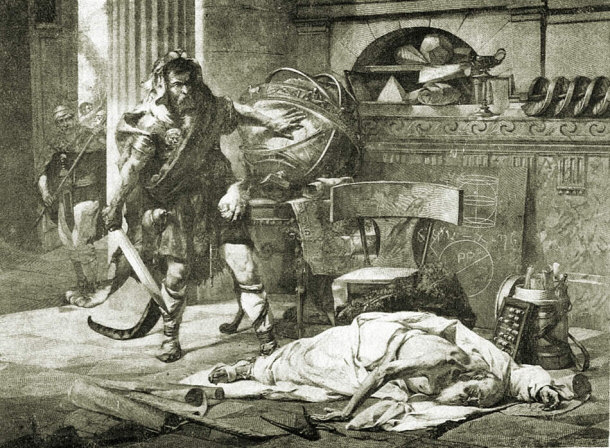
8) Last Words
Focused on Circles
Legend has it that Archimedes' last words were "don't disturb my circles" when a
Roman soldier killed him during the Siege of Syracuse in 212 BCE but what
actually occurred differs based on what version of the story you hear. The most
famous legend of Archimedes' death said he was unaware of the siege and was busy
studying. General Marcellus had commanded Archimedes to come to them because
Rome wanted him alive and when he did not, Marcellus sent a soldier to his home.
Engrossed in his books, Archimedes did not know what was going on when the
soldier entered his home. According to Plutarch, he was contemplating a
mathematical diagram when the soldier came in. Archimedes did know who the
soldier was and became angry when he kicked around the books, this caused the
soldier to get mad then he killed Archimedes with his sword.
A similar version says that General Marcellus commanded him to come see him
and sent a soldier but Archimedes said no, he had to finish working on the
problem. He said "don’t disturb my circles" when the soldier disturbed his works
and those were his last words, apropos for such an influential mathematician as
well as important contributor to geometry. Another alternative story of his
death was that he was carrying math instruments as he walked to General
Marcellus after the siege; the solider accompanying him thought these
instruments were valuable and killed him for them.
Archimedes contemplating math
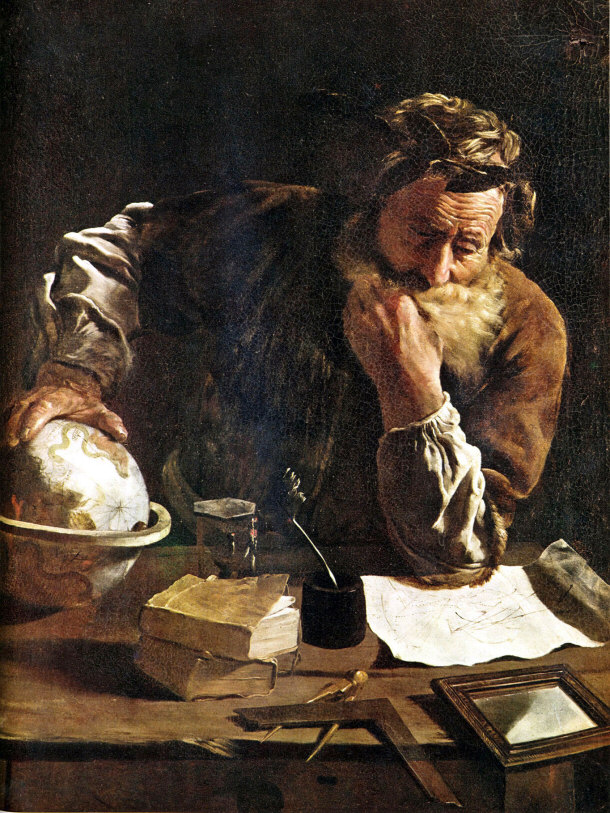
7) Inventor of
Calculus
Archimedes was using aspects of calculus more than 1500 years before Isaac
Newton and Gottfried Leibniz discovered what it was. For a long time Archimedes'
use of integral calculus was lost but when the Archimedes' Palimpsest was
discovered in 1906, the Method of Mechanical Theorems was found. This detailed
his use of infinitesimals and demonstrates how you can break up a figure into
infinite parts. He used a method known as the method of exhaustion and this is
how he was able to figure out the value of Pi. Many mathematicians consider
Archimedes to be one of the first to use calculus, although Newton and Leibniz'
work still plays a more significant role in the actual study as well as use of
calculus.
Tangent Line in Calculus
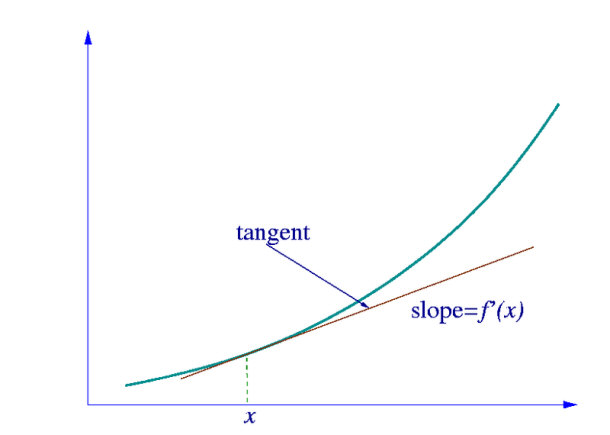
By Tangent-calculus.svg, via
Wikimedia Commons
Isaac Newton
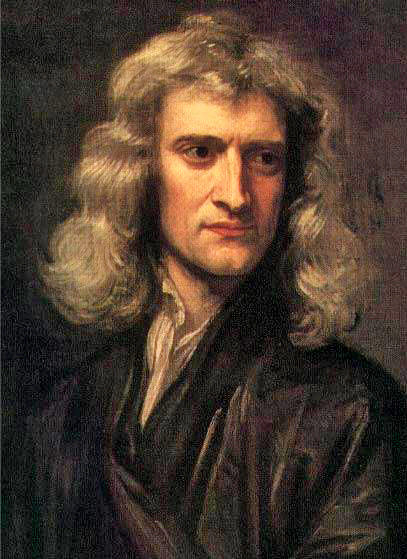 |
Gottfried Leibniz
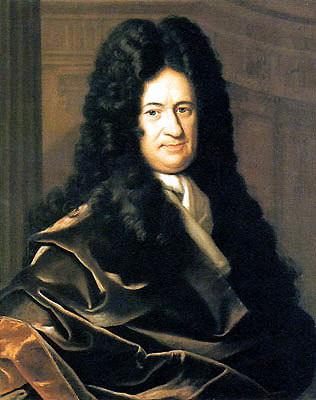 |
6) Studied in
Alexandria
Archimedes lived in Syracuse almost all his life but he went to school in
Alexandria, which was the intellectual capital of the world at the time.
Archimedes was sent off to school and studied at the school of Euclid, the
famous mathematician. Euclid is known as the father of geometry, making him the
perfect teacher for Archimedes. Euclid's Elements was the main textbook for
geometry and other math from around 300 BCE until the late 19th century. His
works have a huge influence on mathematics as we know them and Archimedes
learned a great deal from him.
There is some small debate about whose works came first, since not much
detail is known about Euclid and when his works were published. A few scholars
have tried to say that Archimedes' citation of Euclid's works came from later
additions and sources but most scholars agree that Euclid's Elements were
published before Archimedes.
Two important contemporaries of Archimedes that Archimedes probably met at
school were Conon of Samos and Eratosthenes of Cyrene; they remained friends
even after Archimedes went back home to Syracuse. Two of his works, the Methods
of Mechanical Theorems and the Cattle Problem, include instructions addressed to
Eratosthenes. In some of his writings, he referred to Conon of Samos. The
correspondence demonstrates how important Archimedes' education was to him and
the beneficial relationship he had with these men.
The Library of Alexandria
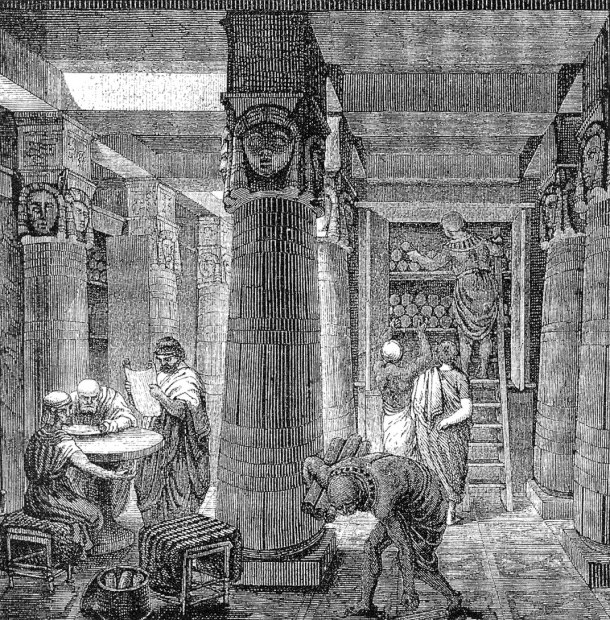
Statue of Euclid
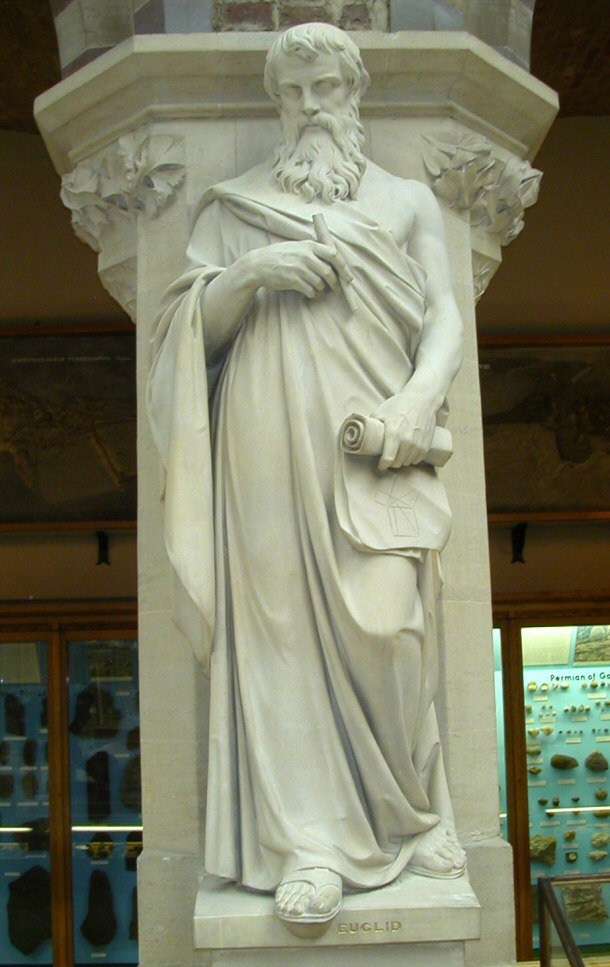
Euclid's Elements fragment
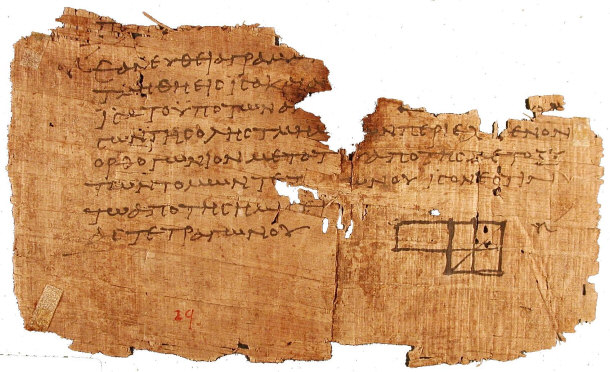
Eratosthenes
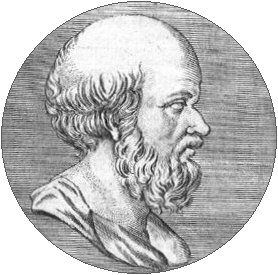
5) One of the Top 3
Mathematicians
|
Principia Mathematica 1686
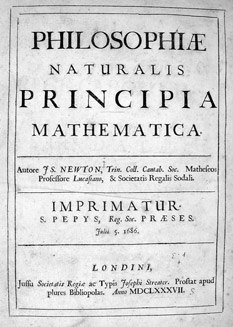
|
Archimedes is thought to be one of the three most influential and important
mathematicians who ever lived; the other two are Isaac Newton as well as Carl
Gauss. Sir Isaac Newton may be known by many as the discoverer of gravity but he
gave the world of math and science so much more than that. Newton lived from
1642 to 1727 and his discoveries as well as theories were very important to the
scientific revolution. His most famous work was the Principia Mathematica, which
detailed his laws of motion and universal gravitation. Newton also is
contributed to discovering calculus along with Gottfried Leibniz.
Carl Gauss was a German mathematician who lived from 1777 to 1855 and is
thought by many to be the most influential mathematician since antiquity. He
contributed greatly to a variety of fields, including: algebra,
statistics, differential geometry, astronomy and more. Without these three men,
living centuries and even millennia apart, the world of mathematics as well as
scientific discovery would not be what it is today.
Carl Gauss
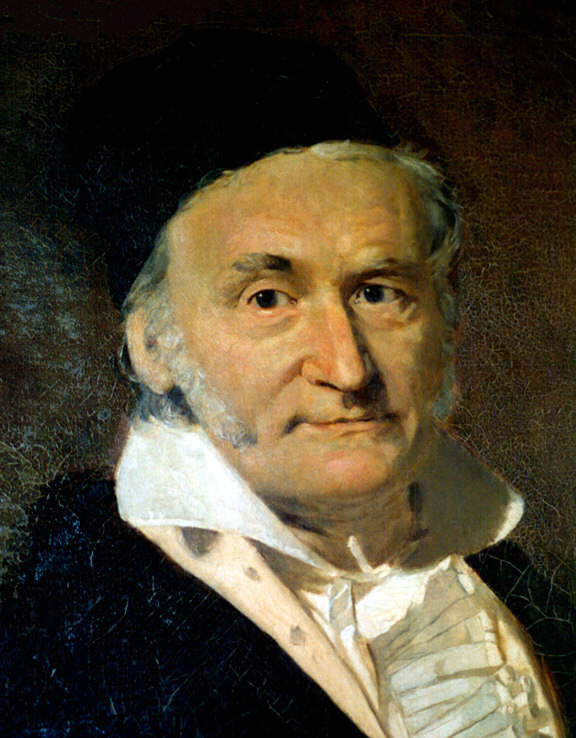
4) Was Possibly
Royalty
Not much is known about Archimedes' personal life however, many believe he was
most likely related to the king and thereby considered to be royalty.
Archimedes' possible royal lineage is mostly attributed to Plutarch writing that
Archimedes was related to King Hiero II in his "Parallel Lives" and the fact
that many of the legends surrounding Archimedes connect him with the king means
there is a strong possibility that he was royalty. Regardless, Archimedes was
definitely not a pauper, he had at least some influence with the king and was
respected. The king especially appreciated Archimedes' great intellect and
ability to invent, like building ships as well as weapons. Archimedes was able
to go to school in Alexandria, so he must have had at least some money in his
family. All that is really known about his family is that his father was an
astronomer named Phidias and historians only know about Archimedes' father
because Archimedes wrote the information in the "Sand Reckoner". Whether
Archimedes was a royal or not in Syracuse, he is definitely royalty in the realm
of mathematics and science.
Plutarch
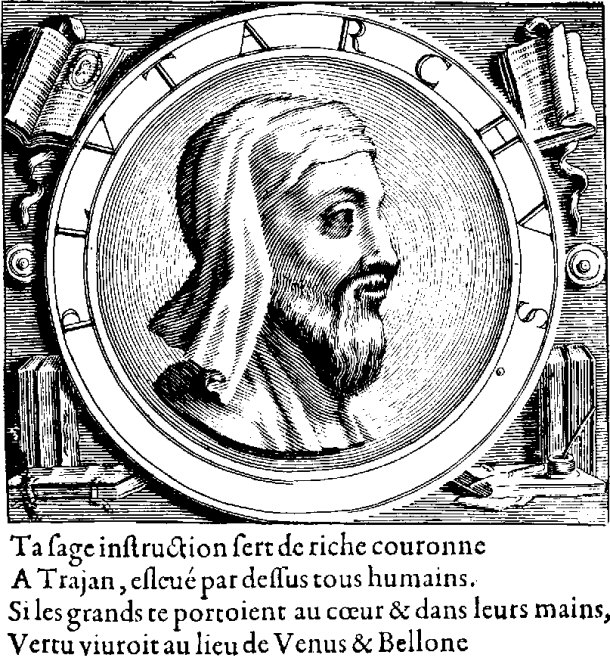
King Hiero II coin
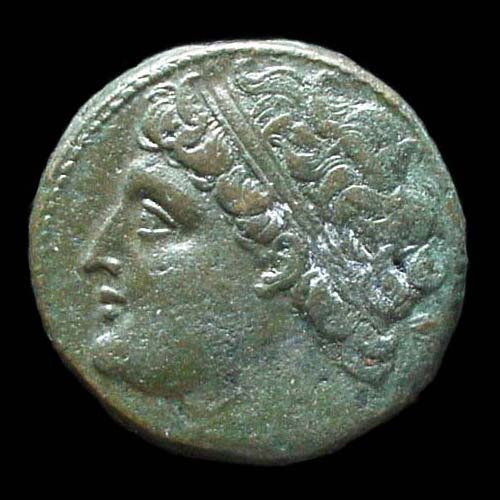
Phidias
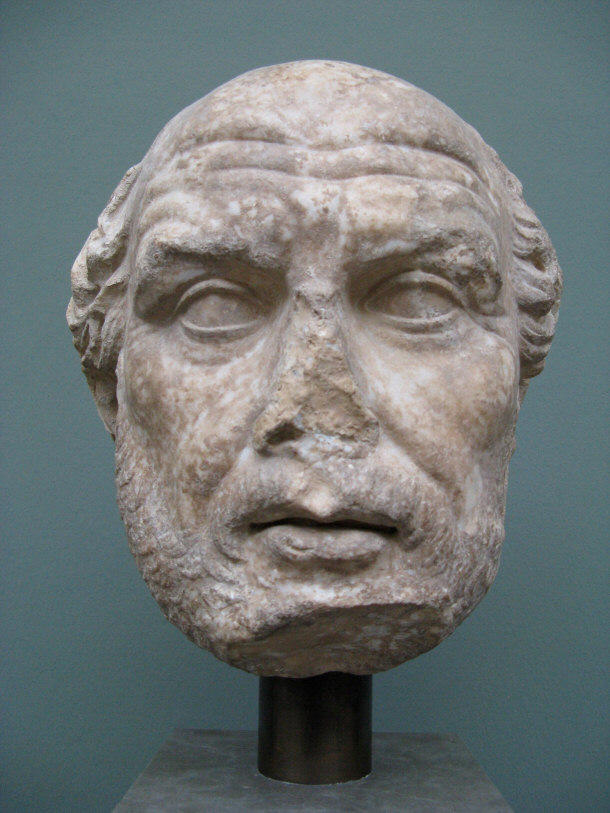
By Yair-haklai, via
Wikimedia Commons
3) Nine Treatises
are Still in Existence
The fact that nine of Archimedes treatises are still in existence today is
amazing, considering he lived over two millennia ago. These treatises discuss
his discoveries in both mathematics and science. These treatsies are on:
the Sphere, the Cylinder, the Measurement of the Circle, the
Equilibrium of Planes, the Conoids, the Spheroids, the Spirals, the Quadrature
of the Parabola, Arenarius or sand-reckoner, Floating Bodies and the Method of
Mechanical Theorems. Within these numerous treatises exist all of his major
findings, like: how to measure the volume of a cone, sphere, or circle;
how to define Pi; and more.
On the Equilibrium of Planes discusses how a lever works, demonstrating
Archimedes' extensive study into the tool. He also used these principles to
develop a theory on the center of gravity. Some of these treaties were lost over
time and discovered only recently. However, enough of Archimedes' brilliance
remained in existence to make him an influential mathematician throughout the
centuries. In addition to his own writings and work, many later mathematicians
used his findings, keeping him as well as his work alive. It is amazing that so
many of the discoveries he made in the mid 200s BCE are still considered valid
today.
Archimedes' Quadrature of the Parabola
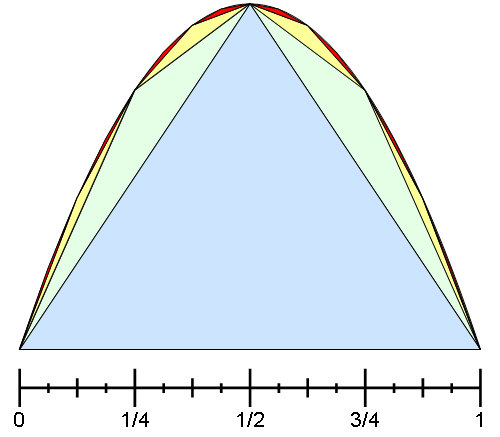
Spiral Treatise

By Guillaume Jacquenot, via
Wikimedia Commons
2) Invented the
Odometer
Many people attribute Archimedes with the invention of the odometer, who lived
thousands of years before the first car was invented. An odometer technically
just measures distance traveled and it can be mechanical, electrical or a
combination. With today's technology, it can even include GPS systems. In
Archimedes' time, an odometer was a cart with a gear mechanism that dropped a
ball into a container as you traveled each mile. Although the first mention of
an odometer was Vitruvius's description around 27 or 23 BCE, many still
contribute the invention to Archimedes. There is a gap in the history of the
odometer between around 200 CE and 15th century Europe even though the odometer
is featured in Archimedes writings during antiquity, showing the ancient Romans
and Greeks did use it. Most likely, the ancient odometer used technology similar
to the Antkythera mechanism. Next time you drive around in your car and look at
your odometer, you can think about the ancient Greeks as well as Romans using a
similar device to see how far they have traveled from home.
Archimedes' Odometer
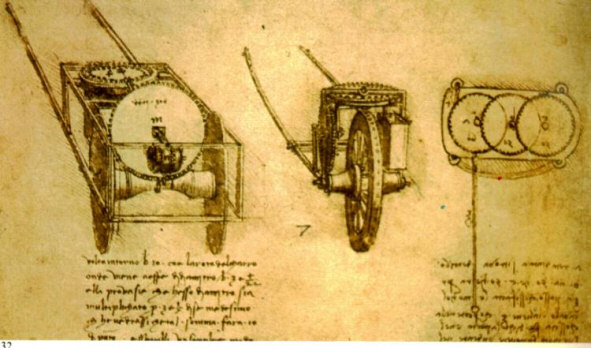
1) More Famous for
his Inventions in his life than Math
Today Archimedes is famous for his mathematical contributions but in his own
life he was more famous for his inventions. Although a few of his contemporaries
that were mainly in Alexandria read his work and even quoted him, it took until
around 530 CE for an actually compilation to be made by Isidore of Miletes. In
the sixth century CE, Eutocius wrote commentaries on Archimedes work and made
them available to a wider audience for the first time. Only a few of his actual
written work survived through the Middle Ages and these findings remained
important to the scientists during the Renaissance. Although there were
discoveries of lost works of Archimedes before this, the major discovery of his
work was in 1906 in the Archimedes Palimpsest. A Palimpsest is when someone uses
old work to write new work by removing the previous text; paper was expensive
during the Middle Ages, so many people would take any old piece of writing, get
rid of the ink and use it again
A goatskin parchment with prayers written on it from the 13th century was
discovered in 1906 and historians discovered that this 174 page book was
actually a palimpsest, underneath was a 10th century copy of many unknown
treatises by Archimedes. It was a major find, especially as historians only know
of three texts of Archimedes' actual treatises in the original Greek. One was
lost in 1331, one in 1550 and the third was lost but then found in 1907. The
find of the Archimedes Palimpsest gave a greater insight into the numerous
contributions by Archimedes in the fields of math and science. Just imagine what
other amazing works are in the world, lost or written over, just like
Archimedes' work.
A piece of the Archimedes' Treatises on a Palimpsest
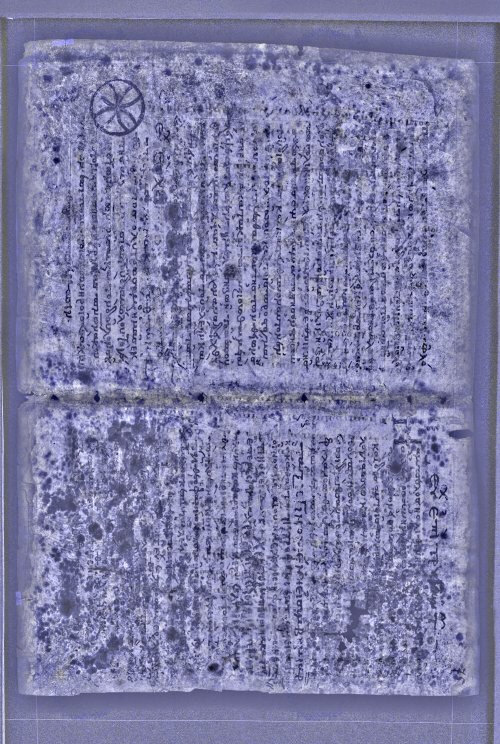
Final Words
Archimedes was famous in his own time but much about his actual life was lost to
history. One of his friends allegedly wrote a biography but over the centuries
it has also been lost. Any information about if he ever married, had a family,
what his personality was like or his private life are now lost to time. All that
is remembered are legends, stories and his remarkable work in his treatises. His
inventions are still used and his mathematical principles are still a vital part
of any math class. Additionally, he has influenced many brilliant minds that
came after him. Beyond his mathematical legacy, Archimedes also influenced
culture and society in another way. Every time someone yells Eureka, they are
copying Archimedes or at least the legend about Archimedes. He was famous in his
own lifetime, so famous that Rome wanted him alive when they plummeted his
hometown. Despite being an old man, who knows what more Archimedes may have
discovered over time if it were not for the soldier who killed him.
Specific People
15 Things You Should Know About Stephen Hawking
15 Fascinating Facts about Michael Jackson
15 Fascinating Facts about Al Capone
15 Interesting Facts about Mother Teresa
15 Interesting Facts about Walt Disney
15 Interesting Facts about George Washington
15 Interesting Facts about Gandhi
15 Interesting Facts about Franklin Roosevelt
15 Interesting Facts about Ben Franklin
Top 15 Interesting Facts about Archimedes
15 Little Known Facts about Martin Luther King
15 Interesting Facts about Ronald Reagan
15 Interesting Facts about Nelson Mandela
15 Interesting Facts About Shakespeare
15 Interesting Facts about Marie Curie
15 Interesting Facts About Julius Caesar
15 Interesting Facts about Leonardo Da Vinci
15 Interesting Facts about Captain James Cook
15 Interesting Facts about John F. Kennedy
15 Interesting Facts About Cleopatra
15 Interesting Facts about Barack Obama
15 Interesting Facts About Albert Einstein
15 Interesting Facts about Adolf Hitler
15 Interesting Facts about Christopher Columbus
15 Interesting Facts About Bill Gates
People Related
15 Most Bizarre Things Purchased by Celebrities
Top 15 Reasons Why People Commit Suicide
25 Individuals Who Thrived with Savant Syndrome
20 Celebrities Who Invented Amazing Things
Top 15 Drugs People Commonly Overdose and Die From
Top 15 Myths about Death
15 Unusual Ways People Have Died
15 Crazy Festivities Around the World
55 Celebrities With Physical Imperfections
15 Funny and Unusual Ways Interviews Have Been Held
15 Weird Ways People Improve Their Confidence
15 Of the Darkest Crime Personalities We Hope to Never Meet
15 People Who Killed for a Living
15 Famous Celebrity Meltdowns
14 Fun Activities That Have Ended Up In Death
15 Facts & Info About Human Trafficking
Shorter Top Lists:
10 Billionaires as Wasteful or Fanciful as They are Wealthy
10 Ruthless Serial Killers Who Were Never Caught
10 Dangerous Serial Killers
Informational:
Detecting Lies: How to Tell Whether or Not Some is Truthful
Cannibalism in History and the Modern World
What Your Favorite Color Reveals About You
What is a Weirdo? Defining Weirdness in Society
Media's Effect on Society
How to Attract Beautiful Women |